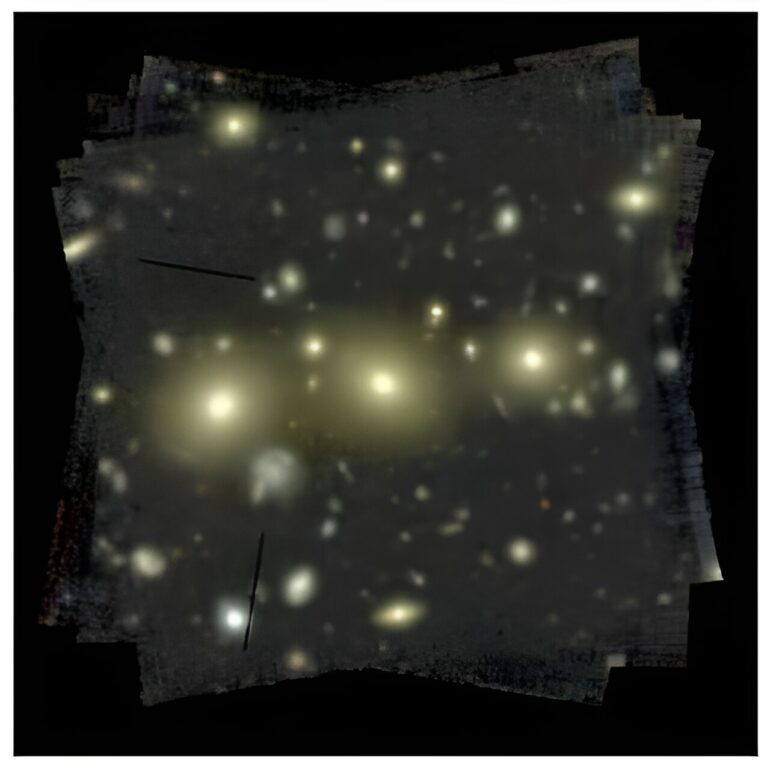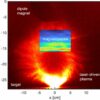A longstanding ‘conspiracy’ in astronomy—that stars and dark matter are interacting in inexplicable ways—has been overturned by an international team of astronomers, in a paper in Monthly Notices of the Royal Astronomical Society.
The authors are based in Australia, the UK, Austria, and Germany, and used the Very Large Telescope in Chile.
The conspiracy emerged to explain a phenomenon that had puzzled astronomers for a quarter of a century. The density of matter in different galaxies appeared to be decreasing at the same rate from their center to outer edges. This was perplexing because galaxies are diverse, with many different ages, shapes, sizes, and numbers of stars. So why would they have the same density structure?
“This homogeneity suggested that dark matter and stars must somehow compensate for each other in order to produce such regular mass structures,” says Dr. Caro Derkenne, the first author of the paper and an ASTRO 3D researcher from Macquarie University.
Like many conspiracies, no researcher could come up with a mechanism. If dark matter and stars could interact in this way, then we would need to change our understanding of how galaxies form and evolve. But they also couldn’t find an alternate reason to explain what they were seeing, until now.
Derkenne and her colleagues found that the similarity in density might not be due to the galaxies themselves but in how astronomers were measuring and modeling them.
The team observed 22 middle-aged galaxies (looking back some four billion years in the past due to their great distance) in extraordinary detail, using the European Southern Observatory’s Very Large Telescope in Chile. It enabled them to create more complex models that better captured the diversity of galaxies in the universe.
“In the past, people built simple models that had too many simplifications and assumptions,” says Derkenne.
“Galaxies are complicated, and we have to model them with freedom or we’re going to measure the wrong things. Our models ran on the OzStar supercomputer at Swinburne University, using the equivalent of about 8,000 hours of desktop computing time.”
Derkenne is now applying her astronomy expertise to complex data for the Australia Public Service.
“Astronomy sets you up really well to understand big data,” she says. “The real world is messy, and we don’t always have all the data. No one is there to tell you the answers or if you’re wrong or right. You need to accumulate data and analyze until you find something that works.”
The project used MUSE (Multi Unit Spectroscopic Explorer) on the VLT to analyze the galaxies from the MAGPI survey (Middle Ages Galaxy Properties with Integral field spectroscopy). MUSE collects spectral data cubes in which every single pixel is actually a spectrum.
“The MAGPI project is a great example of how training workshops and collaborative space within ASTRO 3D have utilized Australia’s strategic partnership with the European Southern Observatory,” says ASTRO 3D Director Professor Emma Ryan-Weber.
“The complex data from the ESO Very Large Telescope has not only solved a long-standing problem in astronomy, but also enabled young scientists, such as Dr. Caro Derkenne, a platform on which to launch their careers to solve real-world problems,” she says.
The co-authors are from the International Center for Radio Astronomy Research (ICRAR) in Western Australia, University of Durham, University of Vienna, the Australian National University, University of New South Wales Sydney, University of Sydney, Ludwig-Maximilians-Universität, and University of Queensland.
More information:
C Derkenne et al, The MAGPI Survey: Evidence against the bulge-halo conspiracy, Monthly Notices of the Royal Astronomical Society (2024). DOI: 10.1093/mnras/stae1836
Provided by
ARC Centre of Excellence for All Sky Astrophysics in 3D (ASTRO 3D)
Citation:
A galactic ‘conspiracy’ disproven: Dark matter and stars not interacting as previously thought (2024, August 20)



